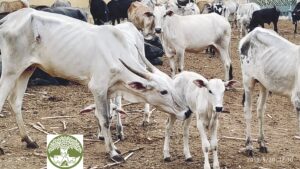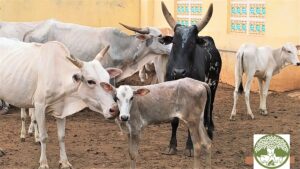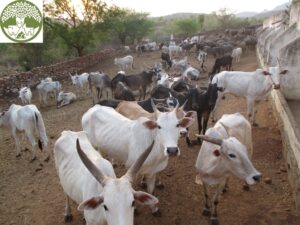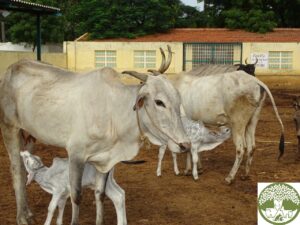Since 2002 Karuna Society has rescued more than 700 cows and buffaloes from illegal transport to the slaughterhouse. About 244 of them are still with us, many advancing into old age. Most of them are castrated (males) and sterilized (females) to stop their reproduction and give them a life unburdened by the business of milk production. However, this puts the burden of caring and feeding them solely on us.
About 70 of these cattle were also freed from the roadside plastic they ingested during their lives (from 20-80 kgs per animal!) thanks to our intervention of the surgical rumenotomy procedure. Our video “The Plastic Cow” on YouTube details our experience in this: https://youtu.be/Nf2V0GT8OJg.
Our rescued cattle live in two groups: one is at the animal clinic/shelter where we keep the old and disabled ones who need special care; and the other group is at Karunapalli village several kilometres away, close to the forest. The 120 cattle at Karunapalli are healthy and are allowed to live their life freely in the herd as they go out grazing most part of the year. A few cows are unsterilized as we could not catch them anymore for surgery, so occasionally there are a few newborn calves. This herd of cattle is slowly “Rewilding”, remembering who they truly are.
In those early years after we rescued the cattle, I wanted to know more about Indian local cow breeds and the history of the “Holy Cow” and so I researched and visited organizations that rescued and kept cattle. Indian cows are very different from the milking cows in Western countries where they take the calf away immediately after birth and the cow will not see it again. Unfortunately this practice is more and more adopted in India at the dairy farms.
Indigenous local cows and buffalo will not let the milk down if the calf is not physically there, so the calves are allowed to sip for milking purposes but many are starving and within a year when the cow is delivering another calf, the yearling calf will be sold!
During a visit to Delhi I visited a “Goshala”, which is a system to protect the indigenous holy cows. Unfortunately, most of them turn out to be milking factories, collecting donations from “Holy Cow” worshippers and selling them the most precious milk and ghee for a good price.
I was allowed to walk around and I observed that everything was clean, spacious and well thought out. While I was standing there, close to a row of milking cows that were all tied up, I became aware that the cow closest to me was very restless. I asked about it and the answer was that she had just delivered her first calf. I asked where it was and they pointed to another enclosure where all the calves were kept. In the meantime she seemed to act more desperate.
We have to be careful not to project our human emotions into her situation. Most probably it is a mix of hormonal changes, pain after childbirth, the surging of the milk into the udders which is new, and a deep urge to protect her child and to take care of it after the trauma of birth. The fact that she was tied up, unable to go after the calf made it even worse and I could physically feel her unbearable anguish and despair. Her child was taken away which she could not bear, nor understand!
I found a series of undercover videos called “Unparalleled suffering”. In this one you see the birth of a milking cow’s calf!
https://www.youtube.com/watch?v=KIbfILdNBsg&t=90s



